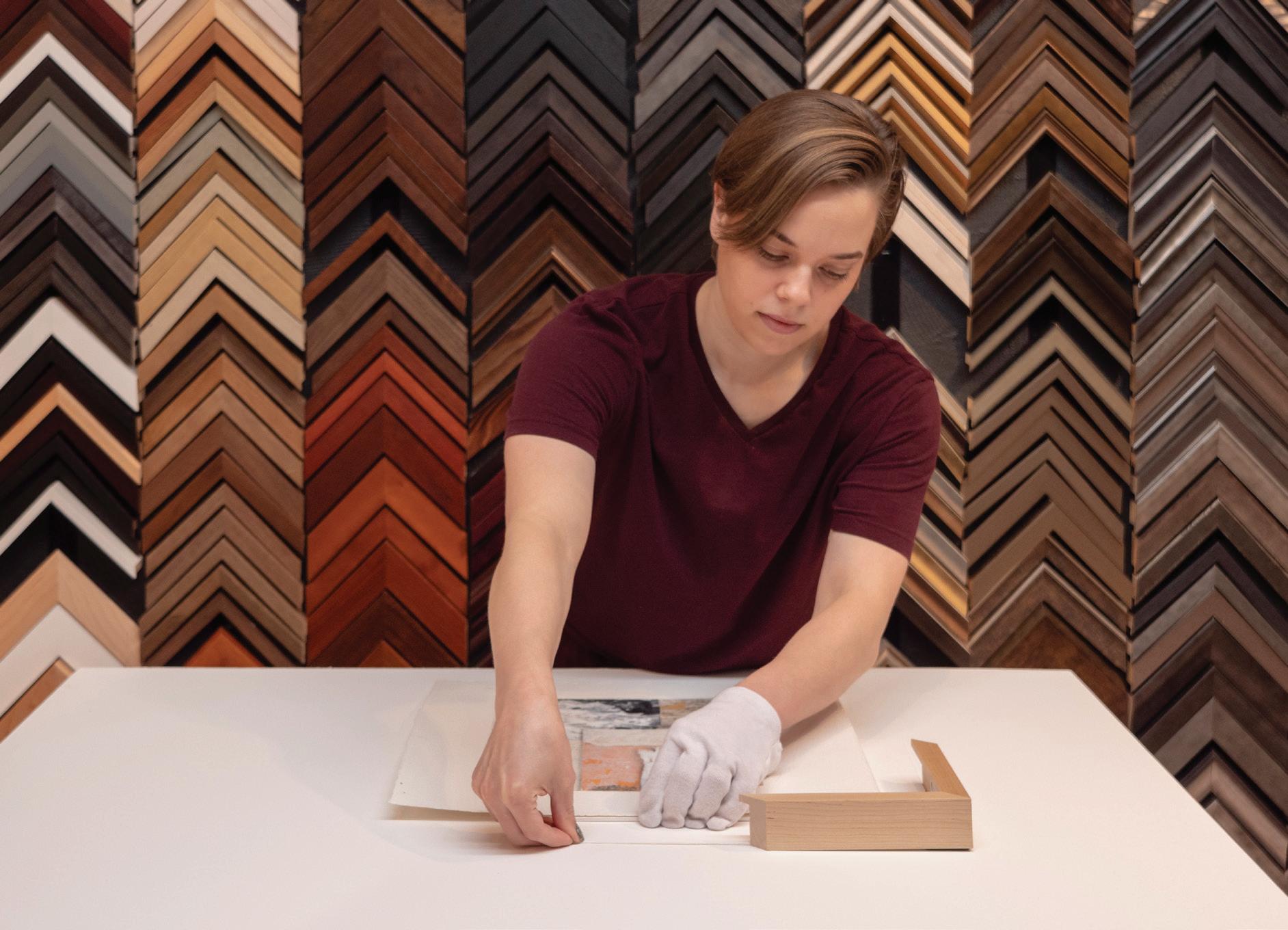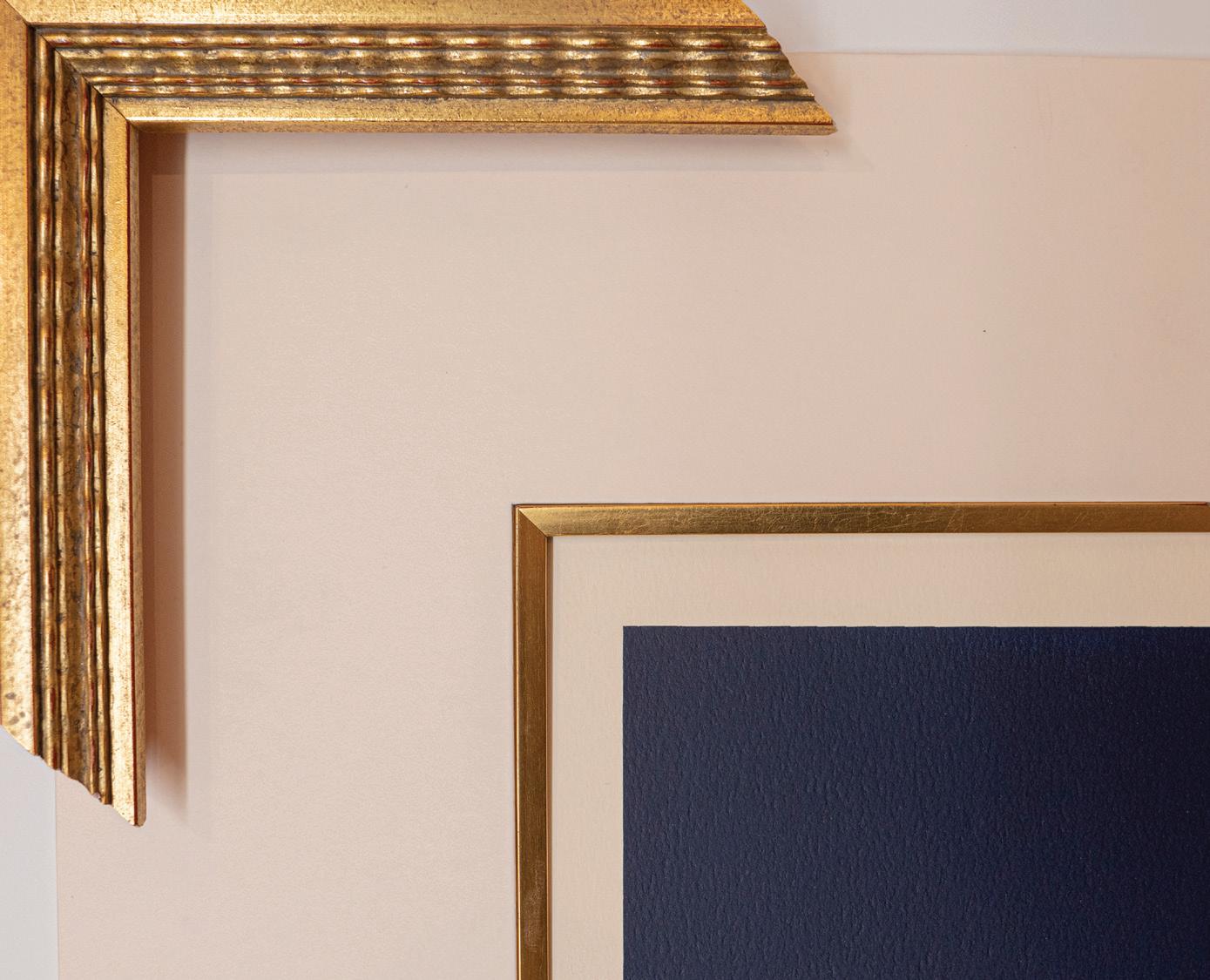
5 minute read
DESIGN TIPS
from OTK Issue 05
by One To Know
Hanging Out
With Alden Williams at Gallery One Frames
Advertisement
By Sonya Cisneros Wierzowiecki Photos by Johnathan Johnson
Hanging artwork takes equal parts of being
fed up and inspired to get it from the floor to the wall. I was reassured that even a professional framer might allow artwork to collect dust for years before finally hanging it. The chore feels so daunting and so sweet when it’s done.
Since joining Gallery One Frames in 2014, Alden Williams brings to framing the skill set afforded by a BFA in Studio Art Sculpture. Her education in art history and the artmaking process help inform the way she approaches each unique design project.
Gallery One Frames
4935 Byers Ave. | Fort Worth, Texas 76107
817-737-9571 | williamcampbellcontemporaryart.com/framing/
Swap a paper mat for fabric.
You can add an element of texture and dimension by using a fabric mat. There are many prefabricated fabric mats on the market now with different types of fabric textures and colors to choose from.

Try a raised float mount.

Mats or foam board lift your artwork off the backing board, which pronounces the paper edge to create depth and a more dynamic aesthetic.

For variety, add a fillet.
A fillet or slip is a small, decorative element that can provide an interesting detail to your frame or window mat. Think of a fillet as framing a picture within a picture to create continuity and dimension.
Height matters.
Depending on whether you have low or high ceilings, a good rule of thumb is to hang artwork 58 to 60 inches from the floor to the center of the piece. One thing to watch for is hanging wire without plastic coating since it can unravel over time. Alden suggests braided metal wire since it holds onto itself easier.
Choose an 8-ply window mat.
If you want to have a mat on top of an image, choose an 8-ply mat, which is thicker than a standard 4-ply mat. This gives the window cut out more presence, which helps draw the viewer’s eye into the image.

MOSTLY A’s: DRAMA QUEEN much? Like the Egyptian pharaoh Cleopatra, you love being the center of attention — and you certainly know how to make an entrance. To introduce herself to Julius Caesar, Cleopatra had herself wrapped inside a carpet and smuggled into his palace — unrolling in full royal garb at the Roman general’s feet. She dressed up like Aphrodite to cruise around on her golden barge (with purple sails), and she hosted elaborate feasts and pranks with her drinking club “Inimitable Livers.” And she had the ultimate party trick: dissolving a priceless pearl in wine and drinking it. Cleopatra’s razzle-dazzle may seem superfluous, but she hugely influenced Roman politics at the Empire’s peak while running her own extensive queendom.
MOSTLY B’s: No one would ever call you PUSHY (to your face). You’re tough, stubborn and defiant, just like Harriet Tubman. Far from the quiet, grandmotherly image many of us have of her, Tubman was a total badass — a fierce warrior woman whose militancy made slaves into free men and women. She did what it took to survive, and she did it on her terms. On the Underground Railroad, she threatened to kill anyone who wanted to turn back and endanger the group (and she carried a pistol to do it). She drugged babies to shut them up and knocked out her own tooth (with the gun) when an infection threatened her rescue mission. The strong-willed woman also worked as a spy for the Union Army, led armed military raids — and pushed her way right into the history books.
MOSTLY C’s: You’re a bit of a WORKAHOLIC who knows how to get things done — like Marie Curie, the brilliant Nobel Prize-winning scientist whose groundbreaking discoveries shaped the modern world. But she would never get a medal for work-life balance. She attended classes by day and tutored at night, often fainting from hunger because her busy schedule left no time to eat (only to get right back up and continue working). Driven and determined, Curie’s dedication to her work competed with her role as a mother, and she frequently relied on others for child care. But her compulsion paid off. Curie’s inventions saved the lives of a million soldiers in World War I alone, and her work led directly to the development of nuclear energy and radiotherapy as a cancer treatment — preventing pain and death for countless humans still today.
MOSTLY D’s: Your wildest days may be behind you, but at heart you’re still kind of a BAD GIRL — and you’re perfectly good at it. So was Empress Theodora, the ferociously powerful wife of Byzantine Emperor Justinian I. Born into poverty but refusing to stay there, she became famous on stage for her daring and provocative acts. But it was her spirited nature that charmed Justinian, who changed the law so he could marry the actress. Theodora became a driving political force, pushing through women’s rights legislation and holding court with foreign ambassadors in her opulent bedchamber. And her penchant for risk-taking behavior even saved her husband’s throne. After a citywide riot broke out and an armed mob called for his head, Justinian prepared to flee — but Theodora was NOT having it. She convinced him to turn around and fight, and he successfully quelled the uprising and saved his empire.
MOSTLY E’s: Ah, the sweet feeling of CONTROL. You’re a perfectionist who thinks you know the best way to do everything, and you usually do — just like England’s Queen Elizabeth I, another clever woman who liked a tight control of everything from Parliament to her wardrobe and portraiture. She hid her flaws (physical and otherwise) with immaculate precision and kept her emotions under wrap, except for the occasional angry outburst. But Elizabeth I also ushered in a Golden Age of literature, exploration and national pride that transformed England into a dominant world power. After all, no one defeats the Spanish Armada by playing it loosey-goosey.










